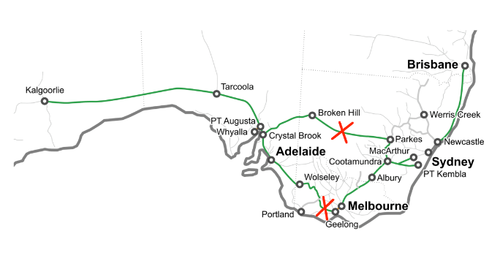
A freight train derailment and flooding have paralyzed vital transportation networks, completely cutting off Perth and Adelaide from Melbourne, Sydney, and Brisbane.
Australian Broadcasting Corporation reported dozens of shipping containers scattered across the tracks when a freight train derailed in Victoria's west on Monday.
Footage from the incident area shows at least 20 shipping containers piled on top of each other and water beneath the tracks. The location of the crash was about 56 miles from Melbourne. There's reason to believe months of heavy might have led to track failure.
The crash has broader implications for the country's transportation network, as ABC explained:
"It is now blocking the rail line between Melbourne and Adelaide, cutting off Adelaide from the Port of Melbourne."
The national broadcaster then pointed out on a map that another critical rail line called Broken Hill was out of order due to heavy flooding, which means:
"No trains are able to go east to west in the whole country. We were hanging by a single thread, which has now been severed."
Here's a map showing the east-west train connection severed.
ABC suggests supply chain misery could move even higher as the east-west train lines were already congested before the weather-related disasters.
The east-west train lines are, according to government statistics, the busiest freight lines in the country. They carry all sorts of goods from Adelaide and Perth to Sydney and Melbourne.
The link between Adelaide and the Port of Melbourne is especially important. Many container ships are extremely large and don't stop in Adelaide. So South Australia relies on goods being unloaded in Melbourne and brought along the rails. It is a 12-hour journey, usually.
The Australian Transport Safety Bureau said it would take time to rebuild the rail line, a possible indication that supply chain disruptions are imminent.
Despite ABC blaming "climate change," we must note the heavy rains are due to an oceanic and atmospheric phenomenon called La Nina. And remember, the UN Office for the Coordination of Humanitarian Affairs has stated:
"El Nino and La Nina are naturally occurring climate patterns and humans have no direct ability to influence their onset, intensity or duration."
What's likely to happen is all freight that would typically be hauled on rail networks will have to switch to the road, and even then, there will be logistical issues due to a limited supply of trucking availabilities.
A freight train derailment and flooding have paralyzed vital transportation networks, completely cutting off Perth and Adelaide from Melbourne, Sydney, and Brisbane.
Australian Broadcasting Corporation reported dozens of shipping containers scattered across the tracks when a freight train derailed in Victoria’s west on Monday.
Footage from the incident area shows at least 20 shipping containers piled on top of each other and water beneath the tracks. The location of the crash was about 56 miles from Melbourne. There’s reason to believe months of heavy might have led to track failure.
The crash has broader implications for the country’s transportation network, as ABC explained:
“It is now blocking the rail line between Melbourne and Adelaide, cutting off Adelaide from the Port of Melbourne.”
The national broadcaster then pointed out on a map that another critical rail line called Broken Hill was out of order due to heavy flooding, which means:
“No trains are able to go east to west in the whole country. We were hanging by a single thread, which has now been severed.”
Here’s a map showing the east-west train connection severed.
ABC suggests supply chain misery could move even higher as the east-west train lines were already congested before the weather-related disasters.
The east-west train lines are, according to government statistics, the busiest freight lines in the country. They carry all sorts of goods from Adelaide and Perth to Sydney and Melbourne.
The link between Adelaide and the Port of Melbourne is especially important. Many container ships are extremely large and don’t stop in Adelaide. So South Australia relies on goods being unloaded in Melbourne and brought along the rails. It is a 12-hour journey, usually.
The Australian Transport Safety Bureau said it would take time to rebuild the rail line, a possible indication that supply chain disruptions are imminent.
Despite ABC blaming “climate change,” we must note the heavy rains are due to an oceanic and atmospheric phenomenon called La Nina. And remember, the UN Office for the Coordination of Humanitarian Affairs has stated:
“El Nino and La Nina are naturally occurring climate patterns and humans have no direct ability to influence their onset, intensity or duration.”
What’s likely to happen is all freight that would typically be hauled on rail networks will have to switch to the road, and even then, there will be logistical issues due to a limited supply of trucking availabilities.






